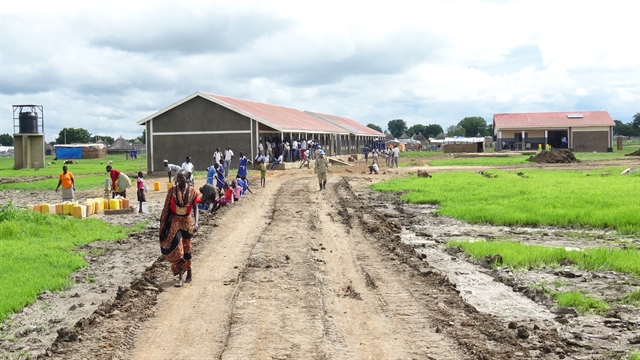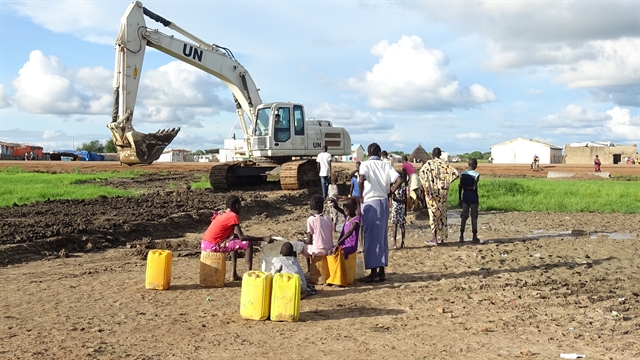 Society
Society

Aware of the situation, the Vietnamese unit set out to talk to the village elders and went knocking door to door to communicate the message of their mission.

|
| A new road in the African town of Abyei, which was recently reconstructed with the help of the Vietnamese Engineering Unit Rotation 1. — Photo courtesy of the Vietnam Department of Peacekeeping Operations |
ABYEI — Three months after their deployment to the African town of Abyei on the UN peacekeeping mission, Việt Nam’s Engineering Unit Rotation 1 has achieved significant results in improving infrastructure and living conditions for the local people.
For years, Abyei, a disputed area between Sudan and South Sudan, has been affected by severe flooding, especially during the rainy season.
Poor living conditions with almost no toilet facilities are also a factor for widespread diseases in the local community.
Abyei’s mayor has called upon the United Nations Interim Security Force for Abyei (UNISFA) to ask for support in developing the water drainage system to relieve the situation.
On July 13, Việt Nam’s Engineering Unit Rotation 1 set out to study the local terrain under the task assigned by the UNISFA.
The field trip revealed one of the most difficult issues in the area that contribute to insufficient drainage system: no slopes, and minor differences in the levels of residential areas and the river water.
The Vietnamese unit proposed to direct drainage flow to two locations: the UNISFA water reservoir and the swamp at the far end of the town.
While the engineering unit had been ready to get to work and prepared three excavators and various dumping trucks for the mission, the challenge remained in the acceptance of the local people.
Aware of the situation, the Vietnamese unit set out to talk to the village elders and went knocking door to door to communicate the message of their mission.
Reducing the distance between the peacekeepers and the local people, and receiving the latter’s approval, construction for the drainage system was allowed to begin.
Within two days after the water flows were redirected and improved, the town’s flooding issues were significantly mitigated.
Taking a holistic approach, the Vietnamese engineering unit continued working to improve the area’s entire drainage system, connecting the main and auxiliary flows in the hope to prevent flood risks in the future.
However, expanding the system means they must restructure the roads in town.
The unit assigned Civilian-Military Coordination (CIMIC) officers to work with the UNISFA and obtained old, discarded sewer pipes.
These pipes were then repaired and used to install 138 metres of circular sewers, and 36 culverts.
To make up for the lack of building materials, the unit improvised by using wooden planks and sandbags to finish the road construction.

|
| Abyei townspeople gather next to an excavator used for road-making. — Photo courtesy of the Vietnam Department of Peacekeeping Operations |
In addition, the Vietnamese unit also worked on a 200-metre-long road to help children go to school easier.
In the past, the road leading to the local school was flooded and covered in mud.
While the team actively worked with local authorities to alleviate the problems, their work encountered multiple challenges due to the high costs of murram - a type of red soil used for road surfaces in Africa, and difficulties in moving soil from place to place in the area.
The solution then was to use old cement from the UN mission to reconstruct the road.
Nearly 100 cubic metres of soil was used to raise the school’s foundation to prevent flooding on a total area of 400 square metres - which was also made into a sports field for the children.
Apart from the new road, Việt Nam’s Engineering Unit Rotation 1 also presented the school with two new garbage incinerators, and three waste containers, alongside one set of pillars, a net and five volleyballs.
During the month of deploying the mission, the unit had spent a total of 700 hundred working days of the entire personnel and 500 hours working with the machinery, moving over 3,000 cubic metres of soil, and dredging more than 20 kilometres of the drainage canals.
Their work has also left a lasting positive impression on the local people.
The town’s mayor Aach Deng Biong personally gifted the Vietnamese unit with four goats – a substantial asset to African people.
Expressing his gratitude, the mayor said that he wished the unit would stay in the area for an extended period of time and provide further support to local people.
Aach Deng Biong also penned a letter to the UNISFA head of mission to commend the support and contributions of the Vietnamese troop.
For the Vietnamese engineering unit, their humanitarian work represents the qualities and traditions of Việt Nam’s army, garnering trust from local people, the UN peacekeeping forces, and the UNISFA.
Their achievements translate into Việt Nam’s responsibility and credibility to the international community and reaffirm the capacity of the Vietnamese engineering units in UN peacekeeping missions. — VNS
BOX
Abyei lies at the centre of the UN peacekeeping mission, spanning a total area of approximately 20 square kilometres.
The town’s population is estimated at 50,000 people. However, detailed statistics are not available due to the complicated security situation in the area.
People lived scattered around the area in the past, but due to increasing conflicts, they have been moving closer to the UNISFA for better security and safety.
The town also has a designated area for civilian protection, where the UN mission offers shelter for refugees coming from other locations against tribal clashes.
Abyei possesses relatively flat terrain with a limited water drainage system, which has resulted in severe flooding during the rainy season. — VNS